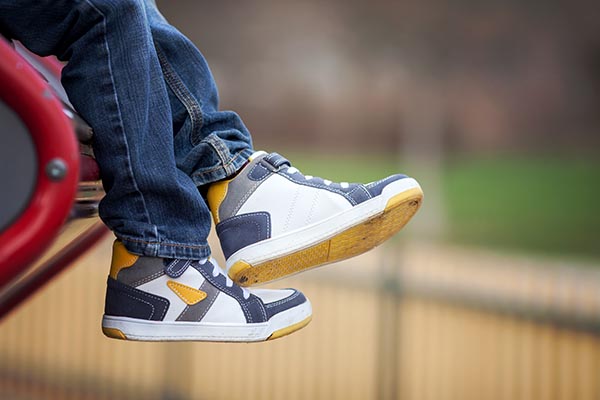We take pride in offering a wide range of foot and ankle services for our community. And we are especially proud of being able to provide effective treatment for pediatric foot and ankle injuries and conditions. We work hard to provide care and treatment for our pediatric patients in a gentle and non-threatening manner to help relieve some of the anxiety and fears that children may have regarding doctor’s offices and medical services/treatments.
Dr. Andrew Marso stands out among the Podiatry community as he is an expert in treating pediatric foot dysfunction, injuries, and foot issues such as ingrown toenails and plantar warts. He also builds rapport with the children to help them feel as comfortable as possible. He has three children of his own, ranging from 2-14 years old, so his experience extends beyond the clinic in how to effectively interact and work with children.
Common Child Foot Conditions and Injuries: Why Does Your Child’s Foot Hurt?
The foot and ankle are complex structures with many bones that fit together like a puzzle and with ligaments and tendons that support the structure. There are many different issues that can arise if something is “out of place” or misaligned. Below are some of the more common pediatric foot conditions that we evaluate and treat.
- Gait Abnormalities. When a child first starts walking, parents can be concerned when they notice either in- or out-toeing. In-toeing tends to be more common and is usually caused by either unusually-curved feet (metatarsus adductus), a twisted lower leg bone (tibial torsion), or a twisted upper leg bone (femoral anteversion). The good news is that these will often resolve themselves in time—and without long-term issues—but it is still a good idea to have us take a look and make sure there is not a bigger problem.
- Pediatric Flatfoot. Foot arches do take some time to fully develop, so there may not be much need for concern if your little one’s feet look flat. At the same time, this can be a structural condition that causes pain and difficulty. The best way to get a complete picture is to bring your child in for professional evaluation. If Dr. Marso determines this situation could result in long-term issues for your son or daughter, he can create a treatment plan to properly address it—and keep your child from a potentially painful issue.
- Heel Pain. When it comes to children and adolescents, the most common source of heel pain is a condition called Sever’s disease. Now, there’s no need to worry—this isn’t actually a disease. Rather, Sever’s is a condition that develops when the heel bone reaches physical maturity faster than the Achilles tendon does. This causes pulling on the back of the heel bone, which is especially painful for your child either during or immediately following physical activity. Treatment is centered on managing the pain, as the condition goes away once the Achilles tendon finishes its natural growth process.
- Ingrown Toenails. Children can be particularly susceptible to ingrown toenails on account of their growing feet. Because their feet grow so rapidly, shoes become tight quickly. And when shoes are tight, toes are crowded in the front. That situation presents the opportunity and likelihood that nails will start to grow into the skin flanking them. Another source of ingrown nails, though, stems from trimming practices. If you clip your child’s nails too short, or rounded, it increases the risk of them becoming ingrown.
- Plantar Warts. For various reasons, kids have an increased risk of developing plantar warts. These warts grow on the bottom of feet, are transmitted by the common human papillomavirus (HPV), and can be rather contagious. Now, they are generally harmless and will go away in time, but warts are embarrassing, can cause discomfort when on the sole of the foot, and may take up to a couple of years to disappear. We provide safe, easy wart removal services for you and your family.
- Sports Injuries. It’s important to be aware of the fact that all sports do have a certain degree of risk for foot and ankle injuries. Fortunately, most sports injuries are successfully resolved without needing surgery. Even better, preventative measures can lower that injury risk and keep your child in the game!
- Juvenile Bunions. Bunions are commonly associated with women’s footwear, but the truth of the matter is that they are often the result of an inherited foot condition. This means that children can develop bunions, just like adults. It is important to start treating a juvenile bunion at the earliest opportunity, since an untreated bunion will progressively worsen.
Proper Footwear for Children
In addition to other prevention methods, it is important to provide children with properly-fitting footwear. More than that, shoes need to be activity-appropriate, constructed from durable material, and provide arch support and sufficient cushioning.
When shopping with your child for footwear, buy shoes of proper size and do not adapt a “they will stretch out” mentality. To help with this, make sure your son or daughter’s toes have room to wiggle and there is about a thumb’s width of space between the longest toe and the front of the shoe. Also, the heel needs to be firmly cradled and you should be able to slide your index finger down to the second knuckle in the back when the shoes are laced.

Expert Child Foot Care Services in Southeastern Wisconsin
For more information on child foot care, or to request an appointment for your son or daughter, simply give Wisconsin Foot Center a call at (414) 425-8400.
Request an Appointment
© Wisconsin Foot Center. All Rights Reserved. Website & Marketing By Podiatry Growth

